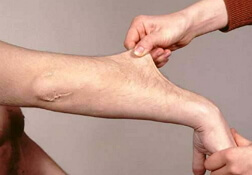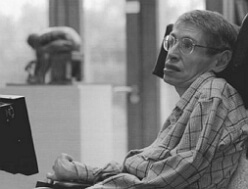Ehlers-Danlos Syndrome
 Ehlers-Danlos Syndrome is a hereditary heterogeneous disease, manifested by hyperelasticity of the skin, which is associated with a defect in the formation of collagen. The Ehlers-Danlos syndrome has different types of inheritance and desmogenesis of the imperfect species. This pathology depends on individual mutations and can manifest as a moderate course of the disease, and life-threatening.
Ehlers-Danlos Syndrome is a hereditary heterogeneous disease, manifested by hyperelasticity of the skin, which is associated with a defect in the formation of collagen. The Ehlers-Danlos syndrome has different types of inheritance and desmogenesis of the imperfect species. This pathology depends on individual mutations and can manifest as a moderate course of the disease, and life-threatening.
Ehlers-Danlos syndrome is considered the most common connective tissue disease and occurs in a ratio of 1: 100,000 newborns. There are no special methods of treatment, only therapy in the form of care, which can mitigate the consequences of pathology.
Ehlers-Danlos Syndrome Causes of
At different times in the study of the hereditary pathology of the Ehlers-Danlos syndrome, there was a classification according to which three to eleven types of disease were distinguished. As molecular and genetic data accumulated, it became necessary to revise the previous versions of the units of the Ehlers-Danlos syndrome. Therefore, in 1997, medical scientists classified the disease into ten types and at the moment it is absolutely close to the causes of the anomaly.
Ehlers-Danlos Syndrome has different types of inheritance for each type. Autosomal dominant is characteristic of the first, second, third, fourth, seventh and eighth, and autosomal recessive inheritance is for the sixth, X-linked for the fifth and ninth, and the tenth has no established type of inheritance, as it is rare.
This disease is an example of a different locus of heterogeneity. It is these loci in which the abnormal changes that cause the Ehlers-Danlos syndrome are directly related to the formation of connective tissue proteins( collagen).These fibers from collagen, as a result of mutations, become irregular in shape and are arranged disorderly. In addition to mutated genes, the reason for the occurrence of the Ehlers-Danlos syndrome is a mutation in those genes in which proteins with an extracellular matrix are localized, and among them, tenascin X, lumikan and decorin are isolated.
Ehlers-Danlos Syndrome Symptoms
The main clinical symptomatology of this disease is manifested in the form of certain disorders in the joints and from the skin, which is characterized by hyperextension.
The healing of wounds takes place for a long time, even with minor cuts, it is also possible the discrepancy of postoperative sutures. As a result, atrophic scars are formed in the form of tissue paper. These scars begin to manifest in those places that are most affected.
For example, a child has a forehead, elbows, knees, after making his first attempts to crawl and walk. The skin in these parts of the Ehlers-Danlos syndrome is very thin. In some patients, subcutaneous nodules in the form of cysts are defined in small sizes. They are easily probed on the forearms and legs. The emergence of these nodes is associated with circulatory disorders and fibrous formation of subcutaneous lobes, which subsequently undergo calcification. Defects of the vascular walls cause the appearance of bleeding, bruising and ecchymosis. Very often in the area of the elbows and on the knees, repeated subcutaneous hemorrhages appear, which are characterized by brown pigmentation.
For normal coagulation status, hemorrhagic changes are characteristic. This fact in the disease should always be taken into account when carrying out operations.
Joints in Ehlers-Danlos syndrome are characterized by hypermobility. It can be determined by the mobility scale of the joints( Beigton).For it, there are five main features: four pairs and one not pair. Also, joint joints are characterized by frequent subluxations and dislocations, including congenital dislocation of the hip, and in addition, and arthralgia of a chronic nature.
Patients with Ehlers-Danlos syndrome suffer from kyphosis, scoliosis, and their associations. At the given pathology there are changes in other somatic organs and systems. To the pathological process, violations from the organs of vision will be added: retinal detachment, keratoconus, myopia and sclera with a blue tint. On the part of the cardiovascular system, a mitral valve with prolapse and aortic dilatation is detected.
Another characteristic symptom of Ehlers-Danlos syndrome is muscle hypotension, which is manifested by a delay in motor development and fatigue. Thus, this symptom leads to the appearance of characteristic hernias, the omission of somatic organs. Among obstetric problems, premature ruptures of the membranes, which lead to premature births and postpartum hemorrhage, are distinguished.
For the classic type of disease, which includes the first and second types of Ehlers-Danlos syndrome, hypermobility of the joints, hyper-extensibility of the skin and scars atrophy are characteristic. When diagnosing this type, additional symptoms are also revealed. In this case, the skin has a velvety and smooth surface, subcutaneous fibrous tumors are formed, complications arise due to hypermobility of the joints in the form of stretches, dislocations, subluxations and flat feet. There is also hypotension of the muscles, there is insignificance in the ecchymosis, increased extensibility and fragility of the tissues in the form of cervical insufficiency, bleeding, divergence of seams and hernias. For the diagnosis to be an important aspect is the presence with similar symptoms of the next of kin.
Skin disorders can vary from moderate to severe severity. But the patella, shoulder and temporomandibular joints are the most susceptible to repeated subluxation. Very often patients of the classical type complain of rapid fatigue.
Hypermobile type of Ehlers-Danlos syndrome is also characterized by increased skin extensibility with a smooth, velvety surface;Generalization of immobility of joints. Additional diagnostic criteria include joint dislocations of a repeated nature, persistent pain in the extremities and joints, as well as the identification of a family predisposition. This type is dominated by hypermobility of the joints with minor cutaneous manifestations. The stretchability of the skin is variable and the atrophy of the scars is not typical. However, the muscular and joint pains begin very early with debilitating and chronic character.
For the vascular type of Ehlers-Danlos syndrome diagnostic criteria are based on: transparent and thin skin, extensive hemorrhages, ruptures of the uterus, intestine and arteries. With additional diagnosis, atrophy of the gingival margin, varicose veins with early manifestation, clubfoot, hypermobility of small joints, pneumothorax;From a family history - a positive result, as well as a sudden death of close relatives who did not live to the age of fifty, as a result of a rupture, sometimes, of the intestine or arteries.
With the two main symptoms, it is safe to diagnose the vascular type of Ehlers-Danlos syndrome and to prescribe a laboratory test. In patients of this type of skin, the skin is tense, the nose is narrow, and the lips are thin, the cheeks that have fallen with pronounced exophthalmia as a result of a lowered fat layer under the skin. This phenotype is observed only in adult patients, and in children it is less pronounced.
Hypermobility of the joints is noted only on the fingers. Spontaneous arterial ruptures occur with maximum frequency in the third-fourth decade of life, however, they can appear earlier. Much more often arteries of medium size are involved in the process. During pregnancy and childbirth complications can occur in the form of rupture of the uterus, perineum, vagina and uterine bleeding. It is these gaps that lead to frequent deaths.
For the Ehlers-Danlos syndrome of kyphoscoliotic type, there is a diverse articular hypermobility with pronounced muscular hypotension since birth, progressive kyphosis, scoliosis, fragility sclera. In addition arterial ruptures, fragility of tissues, hemorrhages, scars of atrophic etiology, microcornea and the presence of a positive family history are added.
An important point is that if there are three main symptoms, you can assume a diagnosis, and conduct a laboratory diagnosis. And the hypotension of the muscles can be very pronounced, which leads to a delay in the motor skills of the patient. And with severe scoliosis, such patients after twenty or thirty years are not able to move independently. At the slightest trauma, the eyeball may break as a result of the fragility of the eye tissues. Based on the latest data, severe complications of the eyes are now much less than before.
For arthrohalasia of the main symptoms, it is possible to include a severe form of generalized hypermobility of the joints, under which repeated dislocations and subluxations are noted, as well as dislocation of the hip of congenital etiology. Additional criteria include: kyphoscoliosis, atrophic scars, severe skin stretching, haemorrhages that recur frequently, osteopenia with moderate severity, muscle hypotension, and tissue fragility. In such patients, low growth is noted with severe scoliosis and kyphosis, as well as hip dislocation.
The last type of Ehlers-Danlos syndrome is dermatospasis with pronounced brittleness and excessively exfoliating skin. In consistence, it resembles a soft, dough-like mass, on which light hemorrhages appear. This type of disease is characterized by large hernia and umbilical, and inguinal, as well as ruptured membranes early. The fragility of the skin is well pronounced, but the wounds heal without forming atrophic scars.
Ehlers-Danlos Syndrome Treatment of
To date, there are no specific treatments for Ehlers-Danlos syndrome. In general, it is recommended that you limit yourself to physical exertion, observe a gentle regime of the day, and also apply symptomatic therapy.
In the Ehlers-Danlos syndrome, pseudotumors are removed during surgery, surgical correction of the thorax as a result of kyphosis, treatment of organs with eye pathology and cardiovascular system is prescribed. During surgery, it is necessary to take into account the possibility of many complications in the form of bleeding after rupture of the fragile walls of the vessels and the impossibility of this defect being stitched, there may be discrepancies in anastomosis in the intestine and poor wound healing with reopening of postoperative sutures.
Patients with Ehlers-Danlos syndrome are recommended protein diet, which contain jelly, bone broths and flooded. Physiotherapy, physiotherapy and massage are prescribed. Drug therapy includes the administration of amino acids( Nutraminos, Carnitine), vitamins B and E, C, D, mineral complexes( magnerot and magne B / calcium-D3-Nycomed), topical and oral administration of chondroitin sulfate, trophic drugs( Lecithin, ATP,Coenzyme Q10 and Inosine), Glucosamine. These drugs are taken within one or two months, two to three times a year.
Prediction of Ehlers-Danlos syndrome mainly depends on the type of anomaly. Lethal outcome occurs in the pathology of somatic organs and is typical for the fourth type of pathological process, in which there are ruptures of large vessels, intestinal perforation, pneumothorax, spontaneously arising and aneurysm of the vessel wall.
For the second and third type of Ehlers-Danlos syndrome, the prognosis is usually favorable, but how much pathology can affect life expectancy has not yet been elucidated.
People, diagnosed with Ehlers-Danlos syndrome, face life with many social problems. They are constantly in fear of significant and painful breaks, are afraid to remain unemployed because of deterioration in their physical condition, experience a general emotional difficulties. They understand that the Ehlers-Danlos syndrome is a lifelong disability.



